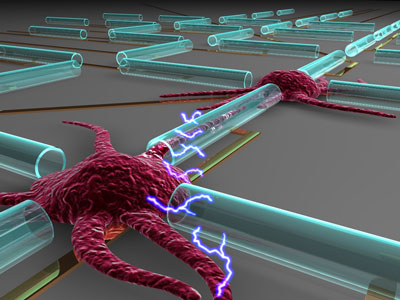Neuronanotechnology: Bridging the Gap Between Neuroscience and Nanotechnology
What is Neuronanotechnology?
Neuronanotechnology is an interdisciplinary field that combines the principles of neuroscience, nanotechnology, and engineering to develop advanced tools and techniques for studying, monitoring, and manipulating the nervous system at the nanoscale. It focuses on the development of nanodevices, nanomaterials, and nanostructures that can interface with neurons and neural networks to gain insights into brain function, treat neurological disorders, and enhance neural capabilities.

Key Concepts in Neuronanotechnology
Neuronanotechnology encompasses several key concepts that enable the integration of nanotechnology with neuroscience:
Neural Interfaces
Neural interfaces are nanodevices that can establish a direct communication pathway between the nervous system and external devices. These interfaces can be used to record neural activity, stimulate specific neural populations, or deliver therapeutic agents to targeted regions of the brain. Examples of neural interfaces include nanoelectrodes, nanowire arrays, and nanoparticle-based sensors.
Nanoelectrodes
Nanoelectrodes are nanoscale devices that can be implanted into the brain to record or stimulate neural activity with high spatial resolution. These electrodes can be fabricated from various nanomaterials, such as carbon nanotubes, graphene, or conducting polymers, which offer excellent electrical properties, biocompatibility, and mechanical flexibility. Nanoelectrodes enable the precise mapping of neural circuits and the modulation of specific neural populations for therapeutic purposes.
Nanoparticles
Nanoparticles are nanoscale structures that can be engineered to interact with neurons and neural networks. They can be functionalized with various biomolecules, such as neurotransmitters, growth factors, or therapeutic agents, to modulate neural activity or promote neural regeneration. Nanoparticles can also be used as contrast agents for neuroimaging, enabling the visualization of brain structure and function at the nanoscale.
Applications of Neuronanotechnology
Neuronanotechnology has a wide range of potential applications in neuroscience research, clinical neurology, and neural engineering:
Neurological Disorder Treatment
Neuronanotechnology can be applied to develop targeted therapies for neurological disorders, such as Parkinson's disease, Alzheimer's disease, and epilepsy. Nanodevices can be designed to deliver therapeutic agents, such as drugs or growth factors, directly to the affected brain regions, minimizing side effects and improving treatment efficacy. Nanoparticles can also be used to clear pathological protein aggregates or promote neural regeneration in neurodegenerative disorders.
Brain-Machine Interfaces
Neuronanotechnology enables the development of advanced brain-machine interfaces (BMIs) that can establish a direct communication link between the brain and external devices. Nanoelectrodes can be implanted into the brain to record neural activity with high spatial and temporal resolution, allowing for the control of prosthetic limbs, wheelchairs, or communication devices. BMIs can also be used for sensory restoration, such as providing artificial vision or hearing to individuals with sensory impairments.
Neural Regeneration
Neuronanotechnology can be employed to promote neural regeneration and repair in cases of brain injury or neurodegeneration. Nanostructured scaffolds can be designed to guide the growth and differentiation of neural stem cells, promoting the regeneration of damaged neural tissue. Nanoparticles can deliver growth factors or other signaling molecules to stimulate neural regeneration and enhance the survival of transplanted neural cells.
Challenges and Future Perspectives
Despite the exciting potential of neuronanotechnology, several challenges need to be addressed for its successful translation into clinical applications. One of the main challenges is the long-term biocompatibility and stability of nanodevices and nanomaterials in the complex biological environment of the brain. Ensuring the safety and efficacy of neuronanotechnology interventions requires rigorous testing and validation in preclinical and clinical settings.
Future research in neuronanotechnology will focus on the development of multifunctional nanodevices that can simultaneously record, stimulate, and deliver therapeutic agents to specific neural populations. The integration of neuronanotechnology with other emerging technologies, such as optogenetics, chemogenetics, and artificial intelligence, will enable the precise control and manipulation of neural circuits for both research and clinical applications. Additionally, the exploration of novel nanomaterials and fabrication techniques will expand the toolbox of neuronanotechnology and open up new possibilities for neural interfacing and neuromodulation.
Further Reading
Advanced Drug Delivery Reviews, Neuronanotechnology for brain regeneration
BioMedical Engineering OnLine, Neuro-nanotechnology: diagnostic and therapeutic nano-based strategies in applied neuroscience
Frontiers in Neuroscience, Advances in Nano Neuroscience: From Nanomaterials to Nanotools
